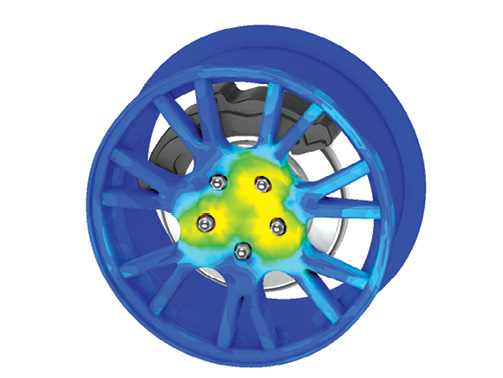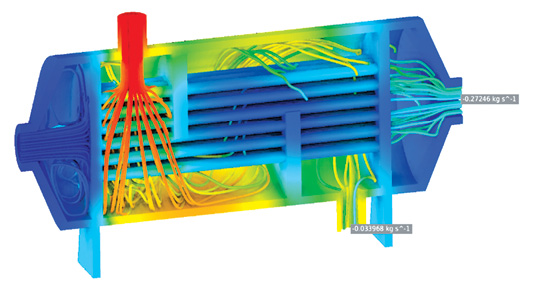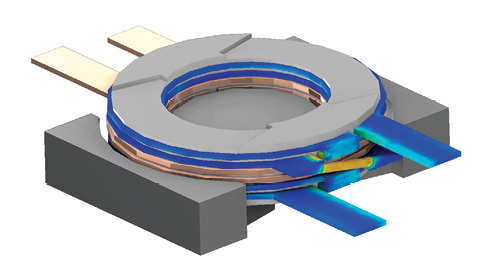
Equivalent stress in a tire rim from bolt tightening. Images courtesy of ANSYS.
Latest News
October 1, 2017
 Simulation has been established as a proven, effective means of streamlining the product development process. It allows companies to analyze product behavior earlier to evaluate more design iterations in the concept/design stage to optimize products, components and systems. However, simulation is often still siloed away in the domain of expert analysts, preventing companies from fully capitalizing on its benefits. As the product design and development landscape evolves to meet demands for developing more customized and complex products faster, simulation throughout the product development process is critical.
Simulation has been established as a proven, effective means of streamlining the product development process. It allows companies to analyze product behavior earlier to evaluate more design iterations in the concept/design stage to optimize products, components and systems. However, simulation is often still siloed away in the domain of expert analysts, preventing companies from fully capitalizing on its benefits. As the product design and development landscape evolves to meet demands for developing more customized and complex products faster, simulation throughout the product development process is critical.
As much as 95% of production costs occur at the design stage, according to a report by the National Endowment for the Arts titled “Industrial Design: A Competitive Edge for U.S. Manufacturing Success in the Global Economy.” It’s easy to see why design engineers need access to simulation tools to aid in the design of better products. Upfront simulation and digital exploration can provide information to make informed decisions, reduce costly physical prototypes, and avoid unworkable designs down the road that lead to expensive engineering change orders. Upfront simulation helps you bring innovation to market faster and at a lower cost.
It does so by reducing the need for expensive physical testing, and allows design engineers to explore more complex product designs in shorter timeframes. This has been enabled by ever-faster, more affordable and accessible computing hardware — both within high-performance computing systems and engineering workstations — that can quickly simulate larger, more complex scenarios. At the same time, simulation software has continued to expand upon the array of physics that can be quickly and reliably simulated.
The adoption of ubiquitous simulation has been slowed in the past by the cost and complexity of the tools — both perceived and actual. Design engineers could not have hoped to have the simulation expertise (or time to acquire it) to run simulations that would help them arrive at the best design. That has changed thanks to easy-to-use simulation tools that are democratizing simulation, making it simple for analysts and design engineers to collaborate early in the design process.
 Equivalent stress in a tire rim from bolt tightening. Images courtesy of ANSYS.
Equivalent stress in a tire rim from bolt tightening. Images courtesy of ANSYS.Simulation used throughout the design process gives engineers time to be innovative — to try and fail and try again until the optimum solution is discovered, all in a streamlined workflow.
The Current State of Simulation
Decades ago, when simulation software first entered the workflow, engineers were initially doubtful that simulation could supplant physical testing, that skepticism has given way. In a number of fields, simulation has virtually replaced physical testing for some phenomena and physics.
However, simulation is still seen as a complicated toolset in general, even for some experienced, dedicated analysts, and especially for intermittent users. Some companies have hesitated to expand simulation earlier in the design process because they were put off the expense and complexity of early simulation software offerings.
But the barriers dividing designers, CAD experts and simulation analysts are beginning to fall away. Traditionally, analysts performed engineering simulations with CAE tools, and design engineers exclusively used CAD applications. But as technology advances and accessibility to sophisticated tools increases, the lines between drafter, designer, engineer and analyst are continually blurring. As a result, many design engineers are developing introductory analysis skills, and benefit from a basic knowledge of simulation.
When it comes to expanding digital exploration to make it pervasive throughout the design process, design engineers have to play a role. There are far more design engineers than simulation analysts. Democratizing the use of simulation relieves the bottleneck many analysts face by offloading some of their work to design engineers. With engineers leveraging intuitive simulation tools early in the process, design can be accelerated and the product development process streamlined, while analysts can be freed up to focus on problems requiring their advanced skillsets.
Pervasive engineering requires simulation tools that engineers can easily incorporate into their day-to-day work processes. Previously, knowledge of analysis and physics was reserved for those with higher-level degrees and those who were proficient with simulation software applications. But in recent years, various software vendors have attempted to target the design engineering market by developing CAD-embedded simulation plug-ins.
Some designers find the limited CAE capabilities of CAD-embedded solutions inadequate. The embedded approach can lead to simulation as an afterthought to CAD, rather than allowing simulation to lead design. Designers may struggle with CAD-embedded simulations, spend more time than desired running them, wind up with results that are not highly accurate, and then still have to rely on analysis experts to achieve their simulation goals.
What is needed is a robust solution that combines the ease-of-use of CAD software with proven simulation solvers. Leveraging this type of modern toolset, designers can incorporate simulation and digital exploration into their work processes. Companies that embrace this type of pervasive engineering will gain a competitive advantage by accelerating and improving their designs, smooth their workflows and ultimately position themselves to create better products.
Make Your Case
Although simulation tools are available that make it easier to use simulation early and often in product design and development, companies who want to benefit from them still face cultural acceptance challenges. Beyond the cost and complexity perceptions leftover from simulation tools of the past, there is a tendency to cling to the status quo. To convince a design engineering team to embrace the future of pervasive engineering, innovators must tailor their approach to address common misconceptions for each stakeholder.
 Temperature contours and streamlines colored by temperature for a shell and tube heat exchanger simulation.
Temperature contours and streamlines colored by temperature for a shell and tube heat exchanger simulation.The digitization of manufacturing will require all hands on deck when it comes to ensuring that product designs can be created and optimized quickly and accurately in a manufacturing sector that will increasingly require flexibility and responsiveness. Manufacturers want the ability to rapidly respond to both customer demand and to quickly be able to identify product defects and improve performance. To remain competitive, companies will need to disrupt or be disrupted.
 Current density in a planar transformer from a magnetic frequency response simulation.
Current density in a planar transformer from a magnetic frequency response simulation.In order to meet these requirements, designers will need the ability to thoroughly explore the design space and generate new product designs without relying specialized analysts to complete an expanding number of simulations.
Learn how to make these shifts in “Making the Case for Digital Exploration,” a free paper produced by Digital Engineering on behalf of ANSYS. It includes an overview of the market, the benefits of upfront digital exploration, advice of how to present those benefits to various stakeholders in your organization and more.
The free download is available at digitaleng.news/de/digitalexploration.

Subscribe to our FREE magazine, FREE email newsletters or both!
Latest News






